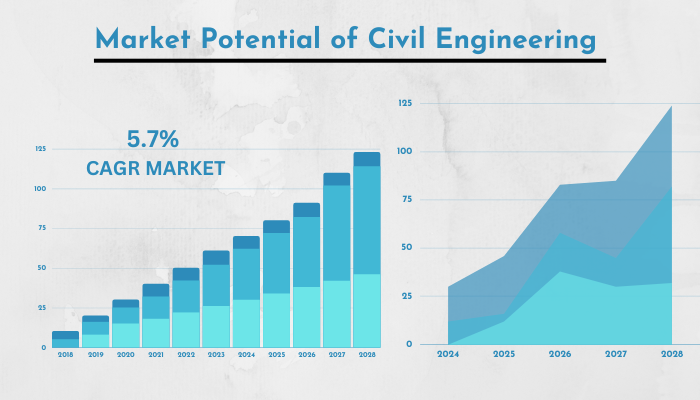Project Report For Civil Engineering
Introduction
Civil Engineering project report is as follows:
A broad definition of civil engineering is that it is a discipline with a great deal of structure where professionals develop, build, and manage infrastructure systems. Along with more specialized construction like buildings, skyscrapers, and houses, these structures may be public works like dams, airports, sewage lines, canals, etc. Civil engineering is often regarded as the second-oldest engineering field in the world, behind military engineering.
A professional degree in civil engineering equips a person with the skills needed to operate in the field of structures and to manage the financial and business aspects of a corporation. Today, civil engineering has its origins in both the public and private sectors, including municipalities, government agencies, and private businesses like builders and homeowners.

Civil engineers are primarily the brains behind designing, organising, and carrying out duties relating to structures and construction. But in the present period, the scope of this profession has expanded to include much more than only construction projects.
Famous civil engineers oversaw the construction of some of the most recognisable buildings in the world, such as the Sydney Opera House and the Burj Khalifa in Dubai. Modern civil engineers are in charge of maintaining public infrastructures, such as roads, railroads, bridges, waste networks, and much more, in addition to designing and carrying out construction projects.
Project Report Sample On
Civil Engineering
Get Completely Custom Project Report
Among the key players in community development are civil engineers. City infrastructure is mostly composed of buildings and roadways. Engineers not only supply them, but also use their expertise to raise the effectiveness and efficiency of social institutions.
Additionally, they create water and sewage systems that strike a balance between safety requirements and the processing of water and sewage, which is essential for the operation of cities as well as the comfort and health of its citizens.
Market Potential Of Civil Engineering
The size of the worldwide civil engineering industry, which was estimated at USD 7.74 trillion in 2020, is anticipated to increase at a CAGR of 5.7% from 2021 to 2028. Growth in the market is predicted to be fueled by emerging nations’ rapid industrialization and urbanisation as well as the increasing global emphasis on building high-quality infrastructure.
The growth of the construction sector is anticipated to be boosted by an increase in capital and infrastructure projects, which would in turn fuel demand for the products over the projection period. It is projected that rising consumer disposable income in emerging economies will fuel the real estate segment and, in turn, the industry’s expansion.
In 2020, the market’s largest segment, construction services, generated more than 27% of all global revenue. The expanding population and traffic problems around the world are expected to fuel an increase in demand for various rail structures, tunnels, bridges, and other civil works, which will drive the expansion of the civil engineering industry.
The presence of numerous reputable international civil engineering organisations in the market is expected to cause the planning & design service sector to see the quickest CAGR over the course of the forecast period. Any construction project must include planning and design in order to achieve proper integration of the design and construction processes.

According to projections, the infrastructure sector would experience the highest CAGR between 2021 and 2028. Over the projection period, segment expansion is anticipated to be driven by rising governmental and private investments in the development of infrastructure projects, including railways, roads, airports, canals, and others.
Additionally, a growing preference for designing and creating flexible infrastructure is anticipated to fuel the development of infrastructure applications. 5.9% annual growth is anticipated for industrial application during the projection period.
Global demand for civil engineering services is anticipated to rise as a result of expanding manufacturing operations and increased demand for industrial infrastructure, including R&D, manufacturing, processing facilities, and warehouses.

